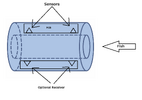I would like to create an underwater fish detector - completely operating underwater (personal project)
The enclosure will be a waterproof hollow cylinder (possible material to use are: acrylic, Polycarbonate or PVC), a PCB will be sealed inside that enclosure containing the sensor (the sensor of choice should not be waterproof because it will be inside a waterproof enclosure).
The fish can pass through that hollow and will be detected while passing. the inner diameter of the enclosure will be in the centimeter range to allow one fish to pass at a time.
Note:
I am not dealing with precise measurements or long range (no need for those expensive high precision sensor)
I cannot use big or expensive sensors due to budget related reasons and size constrain
max operating voltage of the PCB is 12V (preferably 5V or 3.3V)
Here's a link to picture that illustrate the idea for better understanding
 drive.google.com
I am using 2 sensors so i can make sure i detect that it passes through
drive.google.com
I am using 2 sensors so i can make sure i detect that it passes through
optional receivers can be implemented if the sensor i use is just a transmitter and not transducer
Here comes the challenging part, the sensor choice, i will list some i thought about and i hope i can get some ideas from you that can help me.
- Ultrasonic sensor (i saw some people successfully did it but nothing is documented with low cost sensors):
Challenges:
Blind distance of ultrasonic sensor for small measurements.
I don't know if the acoustic wave can pass through acrylic hit the fish and be detected
- Optical sensor (such as VL53L1 or any other choice)
Challenges:
Require clear water
water can scatter the light but i am using it for short distance so i don't know if it will work or not
require transparent enclosure
- ESP32 camera (image recognition algorithm)
Challenges:
Require complex algorithm
Require clear water
I would like to hear if you have any other idea or if i can improve one of the suggested ideas to successfully achieve the project.
Thank you very much.
The enclosure will be a waterproof hollow cylinder (possible material to use are: acrylic, Polycarbonate or PVC), a PCB will be sealed inside that enclosure containing the sensor (the sensor of choice should not be waterproof because it will be inside a waterproof enclosure).
The fish can pass through that hollow and will be detected while passing. the inner diameter of the enclosure will be in the centimeter range to allow one fish to pass at a time.
Note:
I am not dealing with precise measurements or long range (no need for those expensive high precision sensor)
I cannot use big or expensive sensors due to budget related reasons and size constrain
max operating voltage of the PCB is 12V (preferably 5V or 3.3V)
Here's a link to picture that illustrate the idea for better understanding
Untitled.png
 drive.google.com
drive.google.com
optional receivers can be implemented if the sensor i use is just a transmitter and not transducer
Here comes the challenging part, the sensor choice, i will list some i thought about and i hope i can get some ideas from you that can help me.
- Ultrasonic sensor (i saw some people successfully did it but nothing is documented with low cost sensors):
Challenges:
Blind distance of ultrasonic sensor for small measurements.
I don't know if the acoustic wave can pass through acrylic hit the fish and be detected
- Optical sensor (such as VL53L1 or any other choice)
Challenges:
Require clear water
water can scatter the light but i am using it for short distance so i don't know if it will work or not
require transparent enclosure
- ESP32 camera (image recognition algorithm)
Challenges:
Require complex algorithm
Require clear water
I would like to hear if you have any other idea or if i can improve one of the suggested ideas to successfully achieve the project.
Thank you very much.


